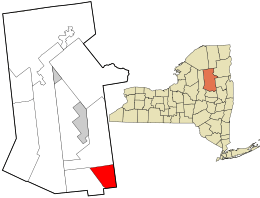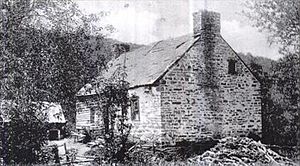Hope, New York facts for kids
Quick facts for kids
Hope, New York
|
|
|---|---|

Hope Town Hall
|
|

Location in Hamilton County and the state of New York.
|
|
| Country | United States |
| State | New York |
| County | Hamilton |
| Established | 1818 |
| Government | |
| • Type | Town Council |
| Area | |
| • Total | 41.64 sq mi (107.84 km2) |
| • Land | 40.70 sq mi (105.42 km2) |
| • Water | 0.93 sq mi (2.42 km2) |
| Elevation | 1,165 ft (355 m) |
| Population
(2010)
|
|
| • Total | 403 |
| • Estimate
(2016)
|
373 |
| • Density | 9.16/sq mi (3.54/km2) |
| Time zone | UTC-5 (Eastern (EST)) |
| • Summer (DST) | UTC-4 (EDT) |
| FIPS code | 36-041-35496 |
| GNIS feature ID | 0979073 |
| Website | http://townofhopeny.org |
Hope is a town in Hamilton County, New York, United States. The population was 403 at the 2010 census.
First settled in 1790 and established as a town in 1818, Hope is located in the southeastern corner of the county and is 49 miles (79 km) northwest of Schenectady.
Contents
History
Prior to European settlement, the land occupied by present-day Hope was within the territory of the Mohawk tribe, the easternmost tribe of the Iroquois Confederacy and one of the original "Five Nations" which founded the confederacy sometime around 1450. Despite its longtime control by the Mohawks, Hope was largely uninhabited when, on July 31, 1772, proprietor John Bergen and 23 of his associates purchased 19,589 acres of land from the Mohawk Turtle Clan. The purchase documents were signed by Mohawk Chief Hendricks, who drew a turtle in lieu of a signature. The land that Bergen and his associates bought became known as "Bergen's Purchase."
Hope was first permanently settled in 1790 near the current south town line by Gideon and Jeremiah Homestead, who arrived from Massachusetts. The first stone house was built in 1801 by David Isdell, on land he had purchased earlier that same year. Wary of Indian attack, Isdell incorporated an escape tunnel in his home for "protection against marauders," but unfortunately, his youngest daughter was notoriously kidnapped by Native Americans while picking berries, and was never heard from again; according to one account she perished in an Indian village. Isdell's home, also known as the "Old Eglin House," collapsed in 1930.
Hope was originally the southern district of the Town of Wells, but after its electors voted to separate and form a new town, the former southern district was established as the "Town of Hope" on April 15, 1818, with a population of 608 as of the 1820 census. In the 1830's, Montgomery County ceded Hope to Hamilton County, of which Hope currently occupies the most southeasterly part. In 1850, with booming agriculture, mining, sawmills, and tanneries, Hope's total population peaked at 1,125, a record which remains unsurpassed, mainly due to residents moving away as a result of industrial decline. The town's area was considerably reduced on April 5, 1860, when a large portion of western Hope, with a population of 380, broke off to form part of the Town of Benson.
While numerous hotels were built during the late 1800's, the population began to decline with the start of the twentieth century, as the town's formerly dynamic industrial businesses began to cease operations. By 1905 the population had fallen to 317 residents, and by 1925 it had plunged to only 163. Much of the formerly developed land fell into desuetude, essentially all industrial operations halted, and a number of the town's one room schools closed. Tourism, however, remained an important industry, and New York Route 30 began to provide travelers with lodging, gas stations, and other amenities. Currently, Hope is a largely undeveloped residential community, with an estimated population of 387 as of 2014.
Geography
According to the United States Census Bureau, the town has a total area of 41.6 square miles (108 km2), of which, 40.7 square miles (105 km2) of it is land and 0.9 square miles (2.3 km2) of it (2.09%) is water.
The south border of the town is Fulton County and the east border is Saratoga County.
The Sacandaga River flows southward through the west part of Hope.
New York State Route 30 is a north-south highway near the Sacandaga River.
Demographics
| Historical population | |||
|---|---|---|---|
| Census | Pop. | %± | |
| 1820 | 608 | — | |
| 1830 | 718 | 18.1% | |
| 1840 | 711 | −1.0% | |
| 1850 | 789 | 11.0% | |
| 1860 | 745 | −5.6% | |
| 1870 | 698 | −6.3% | |
| 1880 | 651 | −6.7% | |
| 1890 | 560 | −14.0% | |
| 1900 | 463 | −17.3% | |
| 1910 | 258 | −44.3% | |
| 1920 | 203 | −21.3% | |
| 1930 | 134 | −34.0% | |
| 1940 | 164 | 22.4% | |
| 1950 | 180 | 9.8% | |
| 1960 | 234 | 30.0% | |
| 1970 | 269 | 15.0% | |
| 1980 | 311 | 15.6% | |
| 1990 | 358 | 15.1% | |
| 2000 | 392 | 9.5% | |
| 2010 | 403 | 2.8% | |
| 2016 (est.) | 373 | −7.4% | |
| U.S. Decennial Census | |||
As of the census of 2000, there were 392 people, 155 households, and 113 families residing in the town. The population density was 9.6 people per square mile (3.7/km2). There were 296 housing units at an average density of 7.3 per square mile (2.8/km2). The racial makeup of the town was 99.49% White, 0.26% African American and 0.26% Pacific Islander. Hispanic or Latino of any race were 1.02% of the population.
There were 155 households, out of which 30.3% had children under the age of 18 living with them, 58.7% were married couples living together, 11.6% had a female householder with no husband present, and 26.5% were non-families. 20.6% of all households were made up of individuals, and 5.8% had someone living alone who was 65 years of age or older. The average household size was 2.53 and the average family size was 2.91.
In the town, the population was spread out, with 22.4% under the age of 18, 7.4% from 18 to 24, 26.5% from 25 to 44, 33.4% from 45 to 64, and 10.2% who were 65 years of age or older. The median age was 41 years. For every 100 females, there were 88.5 males. For every 100 females age 18 and over, there were 93.6 males.
The median income for a household in the town was $32,000, and the median income for a family was $32,000. Males had a median income of $25,000 versus $19,688 for females. The per capita income for the town was $15,225. About 7.8% of families and 12.4% of the population were below the poverty line, including 19.8% of those under age 18 and none of those age 65 or over.
Communities and locations in Hope
- Bennett Lake – A small lake north of Hope Falls.
- Hope – The hamlet of Hope, previously called Hope Center, is on NY-30 and the east bank of the Sacandaga River.
- Hope Falls – A hamlet east of Hope village on Hope Falls Road.
- Maple Grove – A location in the southeast corner of Hope.
- Middle Lake – A small lake between Bennet Lake and Murphy Lake.
- Murphy Lake – A small lake in the northern part of Hope.
- Sacandaga River – A river flowing through the town. Groff creek is a tributary and hiking trail beside it.
Adjacent towns and areas
Benson, New York is to the west, and the Town of Wells is to the north. The Towns of Day and Edinburg in Saratoga County are on the east border. Northampton, Fulton County, New York is the south border.
See also
 In Spanish: Hope (Nueva York) para niños
In Spanish: Hope (Nueva York) para niños


